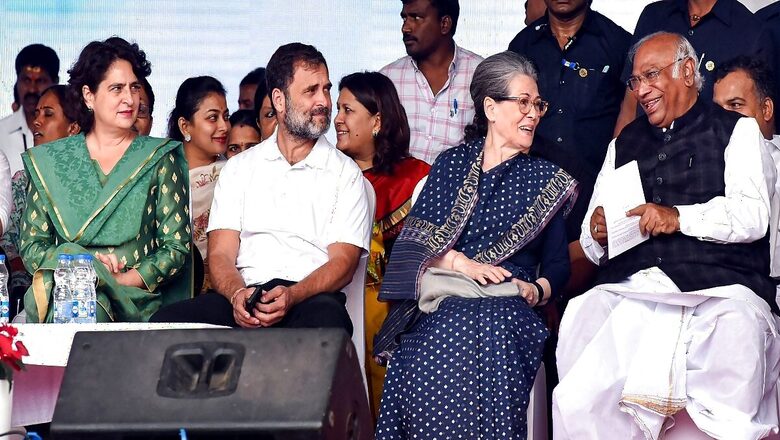
views
We are more than halfway through the ongoing Lok Sabha polls. There is no denying that the Opposition INDIA bloc, led by the Congress, has been able to create a perspective that it isn’t a one-sided battle and that it is for sure not going to be “400 paar” (over 400 seats) for the ruling BJP.
The usual gimmicks of stock market predictions and illegal satta (gambling) forecasts have started to emerge on social media and private WhatsApp groups. However, the underlying message is that come what may, the BJP shall be able to form the government. This probably emerges from the faith the BJP supporters have in the abilities of Prime Minister Narendra Modi being a leader with gargantuan mass appeal.
However, there is also no denying the fact that the Opposition was in tatters when the poll campaign started, but by the passing of time, has been able to create an image of a close fight, which in the end could prove to be just a mirage. Nevertheless, the Congress campaign in the 2024 polls, whatever the results, would remain an area of discussion among the political scientists in the times to come.
The Congress’s poll preparation could be said to have begun from the conclave it held in Udaipur in 2022. The declarations at the Udaipur Shivir talked of building a vibrant organisation. This came in the backdrop of desertions plaguing the party, especially from its most prominent leader Rahul Gandhi’s coterie. Prior to the Congress meeting in Rajasthan that year, leaders from Rahul Gandhi’s charmed circle like Jyotiraditya Scindia, Jitin Prasada, Sushmita Dev, and RPN Singh had already deserted the party.
From Sonia Gandhi’s protected circle, Ahmed Patel had fallen to the coronavirus, Ghulam Nabi Azad had walked out, many had aged, and many passed away. Given the situation, how was the party to revitalise itself? The one right decision it took was to hold the polls for the post of the president of the All India Congress Committee. It did activate the party and in Mallikarjun Kharge, the Congress has found a good campaigner, who not only canvasses hard but makes a lot of sense with what he says.
Strategically, unlike the Vidhan Sabha polls held some months back in the four states, the leadership has consolidated on the alliance despite the initial hiccup caused by its very convener, Bihar chief minister Nitish Kumar walking out of the formation. Though some point out that Kharge and not Nitish was foisted as the chair of the alliance, given his track record, the Bihar chief minister’s opposition to the BJP was always suspect.
The second move by the Congress has been to channelise the strength of the alliance partners to keep itself afloat. To this end, the Congress is contesting only 328 seats this time, significantly fewer than the 421 it contested in the 2019 polls. This number would have been 330, but one candidate’s nomination papers were rejected in Surat, and another withdrew in Indore.
This means that the Congress in INDIA has created an alliance base that is much wider than that of the United Progressive Alliance (UPA). This also means that the party has shrunk from the position of a dominant partner to a senior partner with some other members of the bloc like the Trinamool Congress in West Bengal and Aam Aadmi Party (AAP) in Punjab not even entertaining an alliance.
Those in charge of forging alliances for the Congress claim that this time the grouping is much more pragmatic than in 2019. Uttar Pradesh is a case in point. In 2019, the Congress went into the polls alone, with no major allies. Facing both the BJP and the SP-BSP alliance, it contested 67 of the state’s 80 seats but could win only one: Sonia Gandhi in Raebareli.
This time, in alliance with the Samajwadi Party, it is contesting just 17 seats, down by 50. People close to poll planning point out that it has been done to conserve the party resources for more realistic contests. Similarly, in West Bengal, from contesting 40 seats in 2019, the Congress is taking on just 14 seats this time, giving the remaining Ones to its alliance partner, the Left.
The Congress has extended its alliances with Left parties in Andhra Pradesh, giving the Araku seat to the CPI(M) and Guntur to the CPI. It has also partnered with local parties in other states, such as ceding the Dibrugarh seat in Assam to the Assam Jatiya Parishad and allocating three seats to regional parties in Rajasthan.
To avoid repeating past mistakes, the Congress allocated one seat to the Samajwadi Party in Madhya Pradesh. Ironically, the SP candidate’s nomination papers were rejected, leading the Congress and SP to back a candidate running on the All India Forward Bloc symbol. Similar arrangements have been made in Tripura, Jammu and Kashmir, and Ladakh.
How would this affect the final results? The BJP aims to match the Congress’s performance in 1984 when it won over 400 seats. However, it’s important to remember that those 400 seats came as a harvest of the sympathy wave in the favour of the party following the assassination of then Prime Minister Indira Gandhi.
What differentiates the BJP in 2024 from the Congress in 1984 is that it has delivered on its ideological agenda. This has solidified the commitment of its cadre, leading to an expanded poll machinery. This could work both ways. If there is an undercurrent, it would bring bonus points and if there is voter indifference, the performance should not fall below, as they say in commerce, the reserve price.
The writer is author and president, Centre for Reforms, Development & Justice. Views expressed in the above piece are personal and solely those of the author. They do not necessarily reflect News18’s views.




















Comments
0 comment